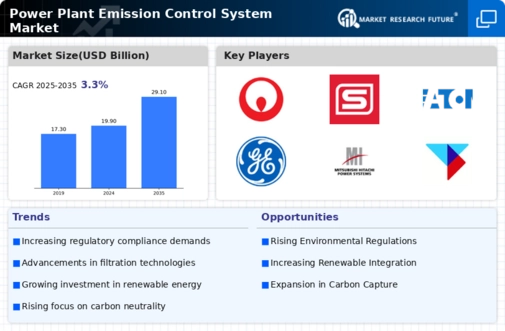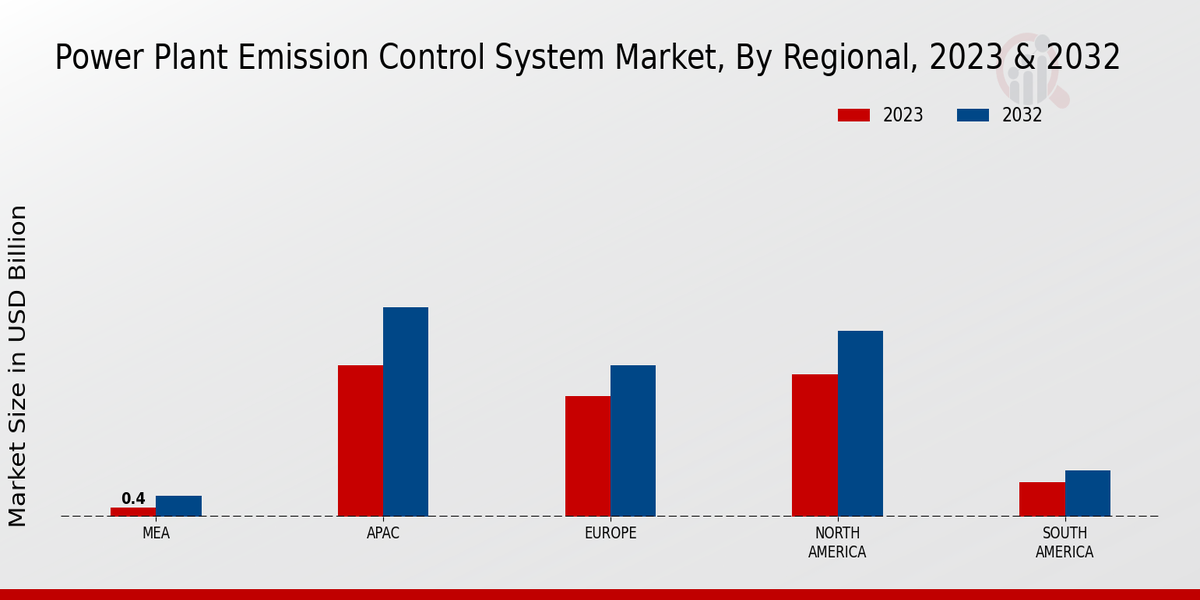Technological Advancements
Technological innovations play a pivotal role in shaping the Global Power Plant Emission Control System Market Industry. The development of cutting-edge technologies such as carbon capture and storage (CCS) and advanced flue gas desulfurization systems enhances the efficiency of emission control. These advancements not only improve compliance with environmental regulations but also reduce operational costs for power plants. For example, the integration of artificial intelligence in monitoring systems allows for real-time adjustments, optimizing performance. As the market evolves, these technologies are expected to drive growth, with projections indicating a market value of 29.1 USD Billion by 2035.
Market Trends and Projections
The Global Power Plant Emission Control System Market Industry is characterized by various trends and projections that indicate its future trajectory. The market is anticipated to grow from 19.9 USD Billion in 2024 to 29.1 USD Billion by 2035, reflecting a robust demand for emission control technologies. The projected CAGR of 3.5% from 2025 to 2035 underscores the industry's resilience and adaptability in the face of evolving regulatory landscapes and technological advancements. These trends suggest a dynamic market environment where innovation and compliance will play crucial roles in shaping the future of emission control systems.
Investment in Renewable Energy
The transition towards renewable energy sources is a crucial driver of the Global Power Plant Emission Control System Market Industry. As countries aim to reduce their reliance on fossil fuels, investments in renewable energy infrastructure are surging. This shift necessitates the implementation of emission control systems to manage the residual emissions from hybrid power plants. For instance, nations like Germany and China are leading the way in integrating renewable sources while maintaining stringent emission standards. This trend not only supports environmental goals but also stimulates market growth, as power plants seek to balance renewable integration with emission control.
Regulatory Compliance Pressure
The Global Power Plant Emission Control System Market Industry is driven by stringent regulatory frameworks aimed at reducing emissions from power plants. Governments worldwide are implementing more rigorous standards to combat air pollution and climate change. For instance, the European Union has established the Industrial Emissions Directive, which mandates significant reductions in pollutants. This regulatory pressure compels power plants to invest in advanced emission control technologies, thereby propelling market growth. As of 2024, the market is valued at 19.9 USD Billion, reflecting the urgent need for compliance-driven solutions.
Growing Environmental Awareness
Increasing global awareness regarding environmental sustainability significantly influences the Global Power Plant Emission Control System Market Industry. As public concern over air quality and climate change intensifies, stakeholders demand cleaner energy solutions. This shift in consumer behavior prompts power plants to adopt emission control systems that minimize their environmental footprint. Governments are also incentivizing the transition to cleaner technologies through subsidies and tax breaks. Consequently, the market is likely to experience a compound annual growth rate (CAGR) of 3.5% from 2025 to 2035, reflecting the growing emphasis on sustainable practices.
Economic Growth and Urbanization
Economic growth and urbanization are significant factors impacting the Global Power Plant Emission Control System Market Industry. As developing nations experience rapid industrialization and urban expansion, the demand for electricity surges, leading to increased emissions from power plants. To address this challenge, governments are investing in emission control technologies to mitigate the environmental impact. Countries such as India and Brazil are witnessing substantial growth in their power sectors, necessitating the adoption of advanced emission control systems. This trend is expected to further drive market expansion, as the need for cleaner energy solutions becomes more pressing.





















Leave a Comment